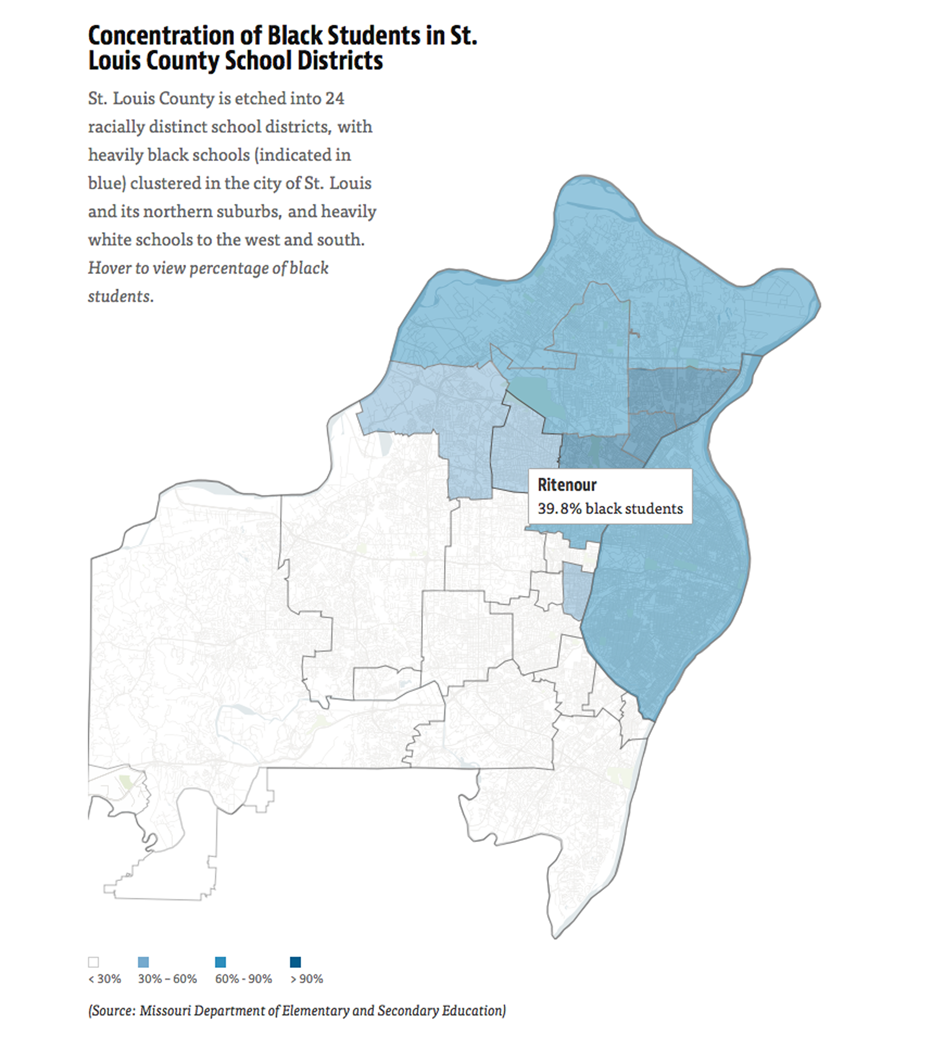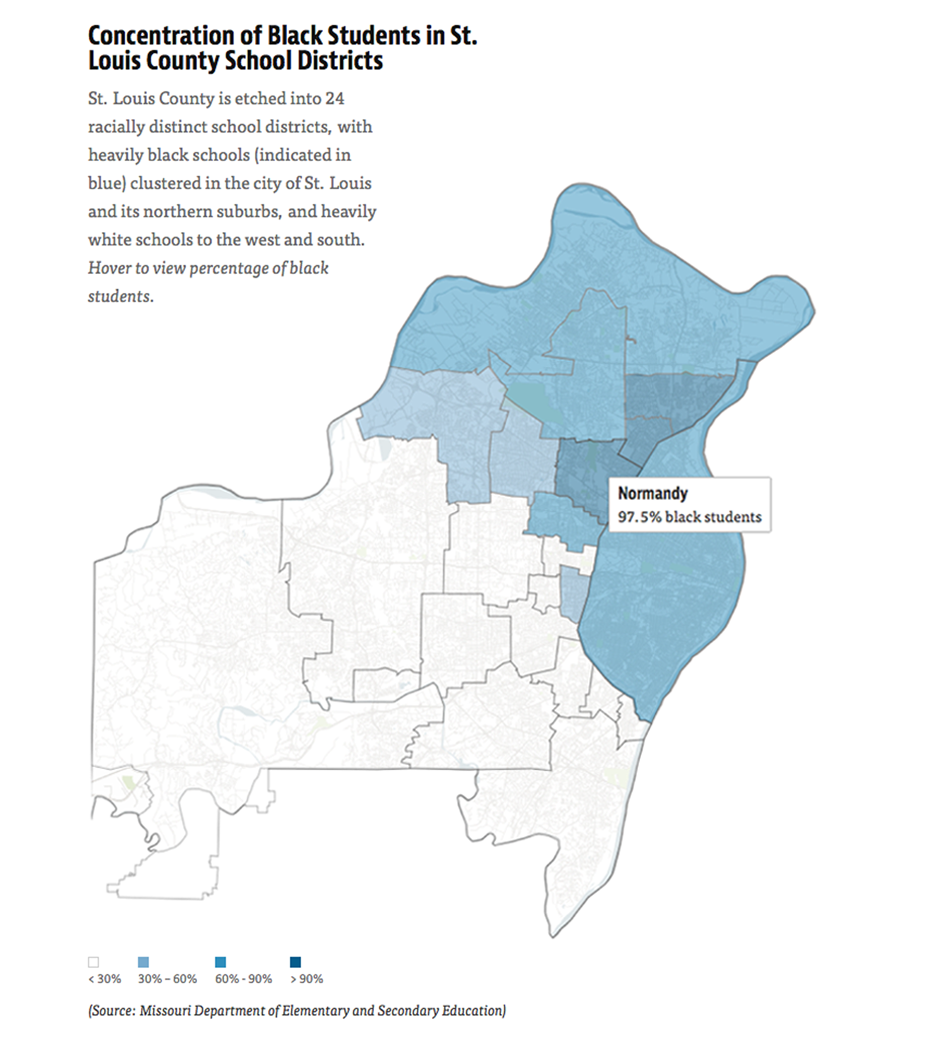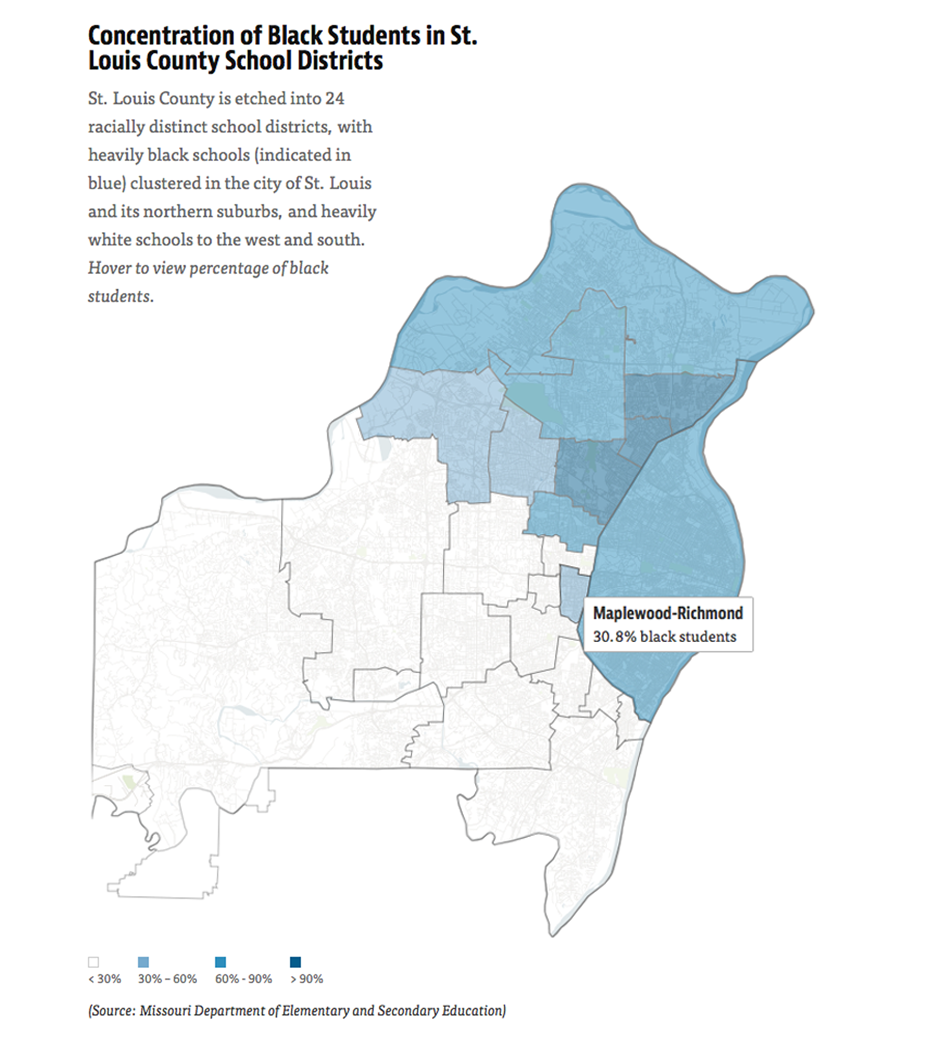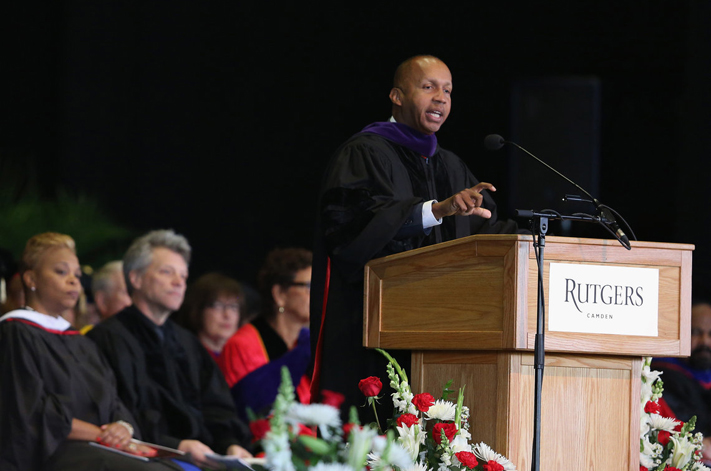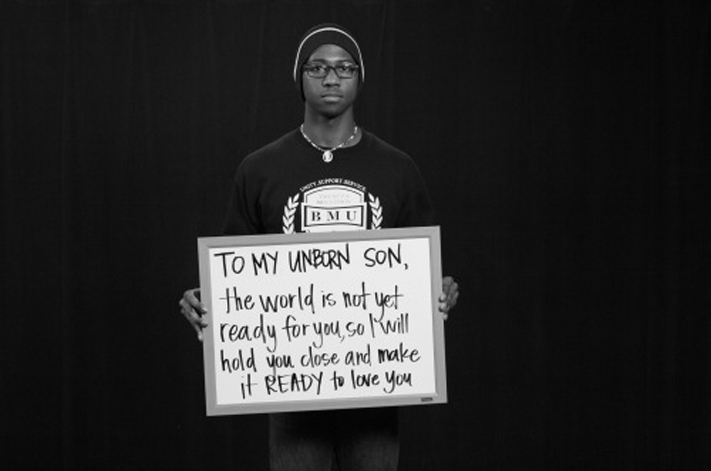Project Description
One of those graduating that day was Michael Brown. He was 18, his mother’s oldest son. He was headed to college in the fall.
Eight days later, Brown was dead — killed in the streets of nearby Ferguson, Mo., by a white police officer in a shooting that ignited angry protests and another round of painful national debate about race, policing and the often elusive matter of justice.
But if Brown’s educational experience was a success story, it was a damning one.
The Normandy school district from which Brown graduated is among the poorest and most segregated in Missouri. It ranks last in overall academic performance. Its rating on an annual state assessment was so dismal that by the time Brown graduated the district had lost its accreditation.
A mere five miles down the road from Normandy is the wealthy county seat where a grand jury recently decided not to indict Darren Wilson, the officer who killed Brown. Success there looks drastically different. The Clayton Public Schools are predominantly white, with almost no poverty to speak of. The district is regularly ranked among the top 10 percent in the state. More than 96 percent of students graduate. Fully 84 percent of graduates head to four-year universities.

Normandy High School walk to a high school where most students read, write and do math below grade level. (Washington Post/Getty Imagesn)
About half of black male students at Normandy High never graduate. Just one in four graduates enters a four-year college. The college where Brown was headed is a troubled for-profit trade-school that a U.S. Senate report said targeted students for their “vulnerabilities,” and that at one time advertised itself to what it internally called the area’s “Unemployed, Underpaid, Unsatisfied, Unskilled, Unprepared, Unsupported, Unmotivated, Unhappy, Underserved!”
#SegregationIs
Fill in the blank and tell us about your everyday experiences with segregation. ProPublica will feature comments and photos tagged #SegregationIs on its site.
A hat tip to our friends at Marketplace for helping inspire this experiment; check out their collection of #GentrificationIs photos from across the country here.
As ProPublica has documented in a series of stories on the resegregation of America’s schools, hundreds of school districts across the nation have been released from court-enforced integration over the past 15 years. Over that same time period, the number of so-called apartheid schools — schools whose white population is 1 percent or less — has shot up. The achievement gap, greatly narrowed during the height of school desegregation, has widened.
“American schools are disturbingly racially segregated, period,” Catherine Lhamon, head of the U.S. Education Department’s civil rights office, said in an October speech. “We are reserving our expectations for our highest rigor level of courses, the courses we know our kids need to be able to be full and productive members of society, but we are reserving them for a class of kids who are white and who are wealthier.”
According to data compiled by the Education Department, black and Latino children are the least likely to be taught by a qualified, experienced teacher, to get access to courses such as chemistry and calculus, and to have access to technology.
The inequalities along racial lines are so profound nationally that in October the department’s Office for Civil Rights issued a 37-page letter to school district superintendents warning that the disparities may be unconstitutional.
What Proficiency Looks like in Clayton and Normandy
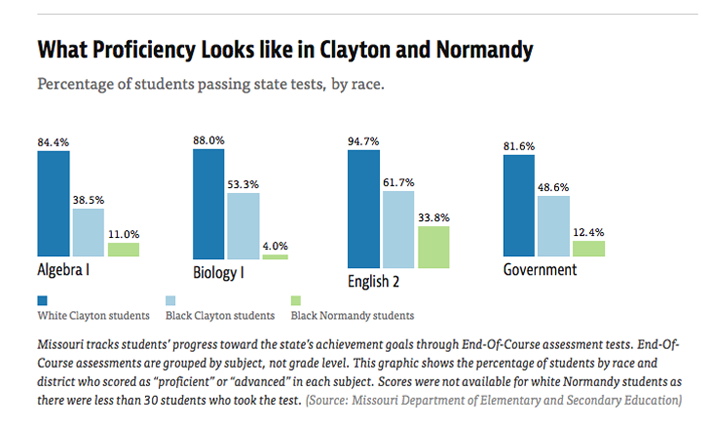
Missouri tracks students’ progress toward the state’s achievement goals through End-Of-Course assessment tests. End-Of-Course assessments are grouped by subject, not grade level. This graphic shows the percentage of students by race and district who scored as “proficient” or “advanced” in each subject. Scores were not available for white Normandy students as there were less than 30 students who took the test. (Source: Missouri Department of Elementary and Secondary Education)
Few places better reflect the rise and fall of attempts to integrate U.S. schools than St. Louis and its suburbs.
Decades of public and private housing discrimination made St. Louis one of the most racially segregated metropolitan areas in the country. Out of that grew a network of school district boundaries that to this day have divided large numbers of black students in racially separate schools as effectively as any Jim Crow law.
In 1983, under federal court order, St. Louis and some of its suburbs embarked on what would become the grandest and most successful interdistrict school desegregation program in the land, one that, at least for a time, broke the grim grip of ZIP codes for tens of thousands of black students. As an elementary school student, under this order, Michael Brown’s mother rode the bus from St. Louis to affluent Ladue.
But like so many other desegregation efforts across the country, the St. Louis plan proved short-lived, largely abandoned after several years by politicians and others who complained that it was too costly. Jay Nixon, Missouri’s current governor, whose response to Brown’s killing has come under intense scrutiny in recent months, helped lead the effort that brought the court order to a close.
Since their retreat from desegregation initiatives, many St. Louis County schools have returned to the world of separate and unequal that existed before the U.S. Supreme Court’s landmark decision in Brown v. Board of Education.
It could be said that the Normandy school district, where Michael Brown spent the last year and a half of high school, never left. Excluded from the court-ordered integration plan that transformed other school systems in the St. Louis area, Normandy’s fiscally and academically disadvantaged schools have essentially been in freefall since the 1980s.
Throughout the region, the educational divide between black children and white children is stark. In St. Louis County, 44 percent of black children attend schools in districts the state says perform so poorly that it has stripped them of full accreditation. Just 4 percent of white students do.
Yet state education officials say there is little political will to change that.
Instead, they have promised to work to make segregated school districts equal, the very doctrine the Supreme Court struck down in the Brown decision.
“We are failing to properly educate the black child,” said Michael Jones, vice president of the Missouri State Board of Education. “Individually, any one person can overcome anything. But we’ve got masses of children with bad starts in life. They can’t win. We ought to be ashamed of that.”

Michael Brown, left, attends a small Normandy High School graduation ceremony in August. Eight days later, he was dead. (Normandy Schools Collaborative/CNN Wire)
Since Aug. 9, the day Michael Brown’s lifeless body lay for hours under a hot summer sun, St. Louis County has become synonymous with the country’s racial fault lines when it comes to police conduct and the criminalization of black youth. But most black youth will not die at the hands of police.
They will face the future that Brown would have faced if he had lived. That is, to have the outcome of their lives deeply circumscribed by what they learn and experience in their segregated, inferior schools.
Dred Scott, Desegregation and a Dearth of Progress
Missouri is what the locals like to call a Southern state with Northern exposure. It entered the Union through a compromise that determined how much of the country would permit slavery and wound up a slave state surrounded on three sides by free states.
It was in a St. Louis case in 1857 that the U.S. Supreme Court handed down one of its most infamous opinions. The court, in ruling against the enslaved Dred Scott, affirmed that black people were not citizens and “had no rights that the white man was bound to respect.”
The spirit of the ruling reverberated for generations in St. Louis, which in the years after the Civil War became the destination for large numbers of former slaves. Indeed, the Mississippi River town became a national leader in how to contain what white real estate agents called the “Negro invasion.”
In 1916, after a successful campaign that included placards urging, “Save Your Home! Vote for Segregation!,” the city’s residents passed a measure requiring that black and white residents live on separate, designated blocks. In doing so, St. Louis became the first city in the country to require housing segregation by popular ballot. The tactic eventually fell to a legal challenge, but white residents found other ways to keep themselves, and their schools, protected from black residents.
One way was to write segregation into the sales contracts of houses. The clauses, known as real estate covenants, ensured the whiteness of neighborhoods by barring the sale of homes to black homebuyers — ever, and across entire sectors of the city. These practices quickly created a clear dividing line in St. Louis that endures to this day: Black people north of Delmar Boulevard; white people south.
In 1948, another landmark St. Louis case led to the U.S. Supreme Court striking down the enforcement of real estate covenants anywhere in the country. The case involved a black resident named J.D. Shelley, who bought a home with a deed restriction and then was sued by a white homeowner, Louis Kraemer, trying to block him from moving into the subdivision.

Schoemehl pots, concrete sewer pipes filled with dirt named for former St. Louis Mayor Vincent Schoemehl. These barricades, ubiquitous in St. Louis, block off the heavily white neighborhoods throughout the city. Each barrier represents the city’s infamous racial dividing line. (Brendan Corazzin)
With legal discrimination under attack in the courts, white residents began abandoning St. Louis altogether. From 1950 to 1970, the city lost nearly 60 percent of its white population. This white flight was partly underwritten by the federal government, which secured loans reserved only for white homebuyers.
Town after town sprung up along the northern edge of St. Louis, some no larger than a single subdivision. Immediately, many forbade rentals and required homes to be built on large, more expensive lots. These devices helped keep neighborhoods white because black residents tended to be poorer and had difficulty getting home loans after decades of workplace, lending and housing discrimination. Even today, 77 percent of white St. Louis area residents own their homes, compared to 45 percent of black residents, the U.S. Census shows.
Some of the tactics employed by St. Louis suburbs, including zoning, also were knocked down by courts.
But court victories, in the end, mattered little. A century of white effort had lastingly etched the county map: a struggling, heavily black urban core surrounded by a constellation of 90 segregated little towns.
“St. Louis yielded some of the starkest racial dividing lines in any American city, North or South,” said Colin Gordon, a University of Iowa professor who traces this history in his book “Mapping Decline: St. Louis and the Fate of the American City.” “I like to think of St. Louis not as an outlier, but one in which all the things we’re talking about are just more visible.”
A Segregation Success, Quickly Abandoned
One legal fight breached — at least temporarily — the St. Louis area’s stark boundaries of home and property, and with them the 24 segregated school districts covering those 90 segregated little towns.
In 1954, the year of the Brown v. Board of Education Supreme Court decision, St. Louis ran the second-largest segregated school district in the country.
In the face of the ruling, school officials promised to integrate voluntarily. But they redrew school district lines around distinctly black and white neighborhoods to preserve their segregated schools. Even so, many white families still left, avoiding the chance of integration by simply moving across municipal lines. By 1980, 90 percent of black children in St. Louis still attended predominantly black schools.
With few white students left, it was clear that a desegregation plan that did not include the white suburbs would be futile. In 1981, a federal judge called for a plan to bus black St. Louis children to white suburban schools.
White suburban residents, and their school leaders, revolted. They filed motions in court and penned angry letters to the local newspaper. The judge, William Hungate, responded by threatening to do the one thing the white suburbs feared more than the bussing plan: Dissolve the carefully constructed school district boundaries and merge all 24 of the discrete districts into a single metro-wide one.
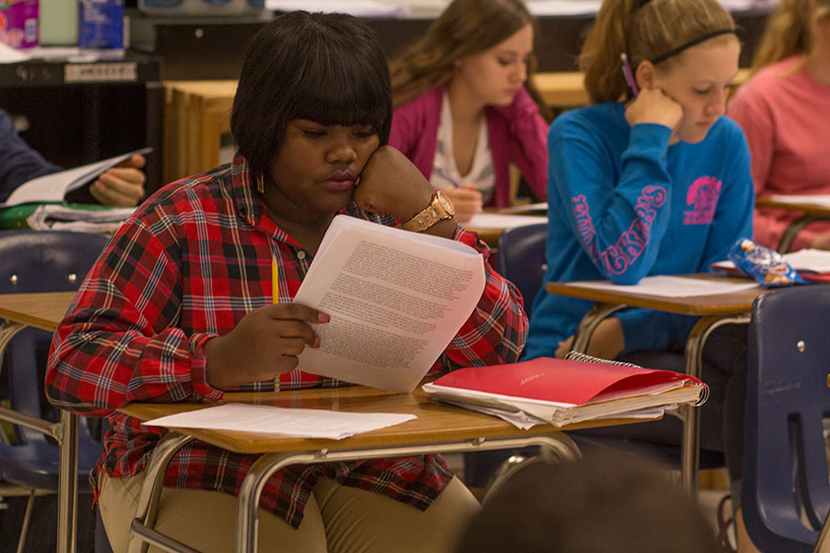
Normandy High School students. Research shows students of all races and incomes do better in integrated schools. (Photographic Credit; Zach Grau for FHC)
The opposition to the plan to bus children out of St. Louis collapsed. In 1983, St. Louis and its suburbs enacted the largest and most expensive interdistrict school desegregation program in the country.
At its peak, some 15,000 St. Louis public school students a year went to school in 16 heavily white suburban districts. Another 1,300 white students headed the opposite direction to new, integrated magnet schools in St. Louis.
The program had its flaws — chief among them, that it left another 15,000 of St. Louis’s black students in segregated, inferior schools. And the transition of black urban students into white suburban schools was not always smooth.
But for the transfer students who rode buses out of the city, the plan successfully broke the deeply entrenched connection between race, ZIP code and opportunity. Test scores for 8th and 10th grade transfer students rose. The transfer students were more likely to graduate and go onto college.
In surveys, white students overwhelmingly said they’d benefited from the opportunity to be educated alongside black students. In short order, St. Louis’s was heralded by researchers and educators as the nation’s most successful metro-wide desegregation program.
But from the moment it started, the St. Louis effort was under assault. It was never popular among the area’s white residents. Politicians, Republicans and Democrats alike, vowed to end the program.
Then-state Attorney General John Ashcroft tried first, appealing St. Louis’ school desegregation case all the way to the Supreme Court. He was succeeded by Jay Nixon, a Democrat who matched Ashcroft’s fervor in seeking to end the program.
“Nixon came from a rural area. His position on school desegregation was more of a Southern Democrat, and it came pretty close to massive resistance,” said William Freivogel, director of Southern Illinois University’s School of Journalism, who covered the Supreme Court for the St. Louis Post-Dispatch during the 1980s and early 1990s. “I once wrote that Nixon behaved like a Southern politician standing in the schoolhouse door.”
Nixon never expressly opposed the idea of integration. His argument centered on what he considered the astronomical costs of the desegregation plan. The price tag, initially in the hundreds of millions of dollars, would reach $1.7 billion.
Nixon, who would not be interviewed for this article, launched a number of legal challenges and prevailed in 1999 when supporters of the desegregation plan ultimately agreed to make the program voluntary. Nixon had successfully challenged Kansas City’s desegregation plan before the U.S. Supreme Court, and some feared he would be similarly successful if the St. Louis case came before the court.
Concentration of Black Students in St. Louis County School Districts
St. Louis County is etched into 24 racially distinct school districts, with heavily black schools (indicated in blue) clustered in the city of St. Louis and its northern suburbs, and heavily white schools to the west and south.
Districts soon began to drop out of the program, and the number of students participating steadily dwindled. Today, the voluntary program remains in place, still the largest of just eight interdistrict desegregation programs in the country. But it is a shadow of what it once was. Some 4,800 students get to escape the troubles of the St. Louis public schools, but each year, the program receives seven times as many applicants as open spaces.
Amy Stuart Wells is a Columbia’s Teachers College professor who co-authored a book, “Stepping Over the Color Line: African-American Students in White Suburban Schools,” on the impact of the St. Louis plan on transfer students.
“I don’t think many people realized how far ahead St. Louis really was,” she said. “There are hundreds of thousands of people in the St. Louis metro area who were affected by this plan, but (the suburbs) did it because they had to and nobody said, ‘Look, we’re a national model for our country.’ There were seeds sewn that could have been so much more.
“This was the epicenter of where people tried to grapple with race, and failed miserably.”
Fears, Flight and a Suddenly Black Suburb left to Crumble
The white flight out of St. Louis left behind a trail of decay, as it did in many large Northern cities. City services lapsed when more affluent residents left. Businesses and jobs migrated as well. The schools in particular suffered.
Not surprisingly, black residents who could afford it looked for a way out, too. They looked to older North St. Louis suburbs, including Normandy. Incorporated in 1945 and covering fewer than two square miles, Normandy became a destination for the city’s fleeing white working class.
Nedra Martin’s family was among the black strivers who began to make their way to Normandy. Martin, who lives in Normandy today and works for Wal-Mart, said her parents first came to the town in 1975. They both worked government jobs — her dad was a welder for the city, her mom an aide in a state group home.
“My parents raised us to know that we are as good as anybody else,” Martin said.
But as black families like the Martins moved in, “For Sale” signs went up. White families started moving out, often to emerging outposts even farther from the heart of St. Louis.
After 1970, black enrollment in the Normandy schools exploded, more than doubling within eight years to 6,200. By 1978, only St. Louis enrolled more black students than Normandy.
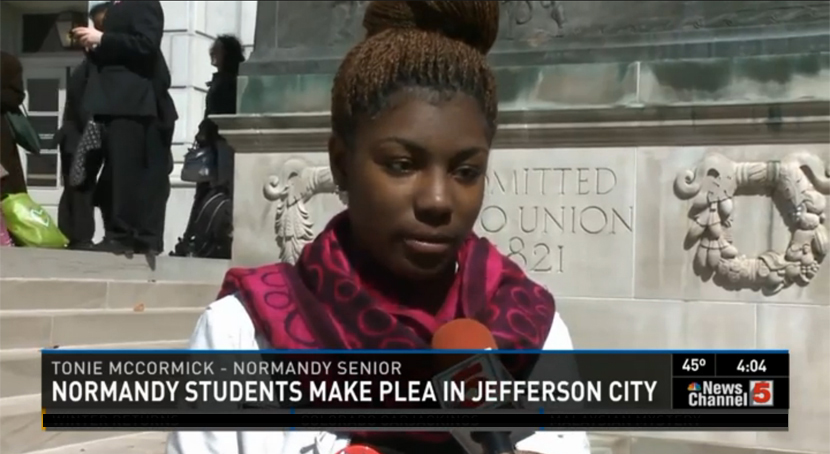
Then and now again, Students take their plea to the state capital, Jefferson City. Decades earlier, Nedra Martin sued the state. Martin said she did it not just for her own child, but “for the parents who are defeated, who feel the same way I feel — that they don’t care about our children’s education.” (KSDK))
Yet Normandy was left out of the metro-wide desegregation order that produced those few years of brighter outcomes for black students between 1983 and 1999. The order capped black enrollment at suburban districts at 25 percent, and Normandy and six other North St. Louis suburbs were already too black.
Instead, the Normandy schools buckled under their swift demographic shift, beginning a steep decline. Many of the best teachers followed the white and middle-class exodus. Instruction fell off. The district suffered from a revolving door of leadership, with principals and superintendents seldom sticking around more than a couple of years. Unable to meet minimum requirements for student achievement, the district clung to provisional accreditation for 15 years.
But black families had less freedom to simply move away to better school districts than even their poorer white neighbors. Housing discrimination continues to keep black families out of communities with quality schools, according to a 2013 St. Louis housing study.
The most affluent black families in Normandy, then, often opted out of the local school system, paying to send their children to private school. As a result, Normandy’s schools ended up considerably poorer and more racially segregated than the communities they serve.
For years, the Normandy school system walked an academic tightrope. Then, in 2009, the state made matters worse.
New Education Commissioner Chris Nicastro decided that it was time to move on segregated districts that consistently failed their students. The state shuttered Wellston, a desperately poor, 500-student district next to Normandy that held the distinction of being Missouri’s only 100 percent-black school system.
One state official had called conditions in Wellston’s schools “deplorable” and “academically abusive.”
The issue for state officials was what to do next with Wellston’s students.
One thing was clear: The students were not going to be absorbed into any of the high-performing, mostly white districts nearby. Jones, the state board of education official, was blunt about why: “You’d have had a civil war.”
The Difference Between Clayton and Normandy
Five miles separate the Clayton and Normandy school districts, but much more sets them apart. Here are some characteristics of the two districts from the 2013-2014 school year.
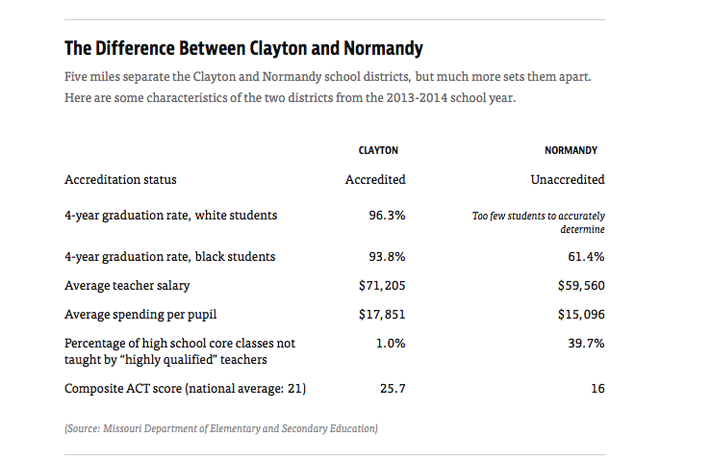
(Source: Missouri Department of Elementary and Secondary Education)
Officials then turned to Normandy, which already enrolled almost 5,000 students. Merging two impoverished, struggling systems made sense to almost no one, especially the officials in charge of Normandy’s schools.
The state went forward with it anyway.
“If you are strictly doing what’s best for all kids, you don’t merge those two districts,” ,a target=new href=http://www.normandy.k12.mo.us/Default.asp?PN=%27News2%27&SubP=%27DNewsStory%27&gn=&DivisionID=&DepartmentID=&SubDepartmentID=&NewsID=40083&ShowNav=&StoryGroup=Archived>Stanton Lawrence, Normandy’s superintendent at the time, said in a recent interview. “Why would you do that? They had written those kids off.”
“It Was All Corrupt Politics”
By the time Michael Brown reached his junior year in high school, he had bounced between local districts and spent most of his career in racially segregated and economically disadvantaged schools. Behind in credits, he enrolled at Normandy High in the spring of 2013.
If he had dreams of academic success, he could not have wound up in a more challenging place to realize them.
The state’s 2014 assessment report on Normandy’s schools was spectacularly bleak: Zero points awarded for academic achievement in English. Zero for math, for social studies, for science. Zero for students headed to college. Zero for attendance. Zero for the percent of students who graduate. Its total score: 10 out of 140.
Out of 520 districts in the state, Normandy, where 98 percent of students are black and 9 of 10 were poor in 2013, is marooned at the very bottom.
Decades of research show that segregated, high-poverty schools are simply toxic for students of all races and backgrounds. Just last month, the University of North Carolina at Chapel Hill released a study showing that black first-graders in segregated schools performed worse than black students with the same backgrounds (meaning poverty, parental education and other factors) who attend integrated schools
But for a moment prior to the start of Brown’s senior year, the Normandy district’s students were thrown an unlikely lifeline.
Just two years after the merger with Wellston, Normandy’s schools were performing so poorly that the state stripped Normandy of its accreditation altogether. That triggered a state law requiring that any student there be allowed to transfer to an accredited district nearby. The law had been challenged by suburban districts uninterested in absorbing kids from failing schools, but in 2013 the Missouri State Supreme Court upheld it.
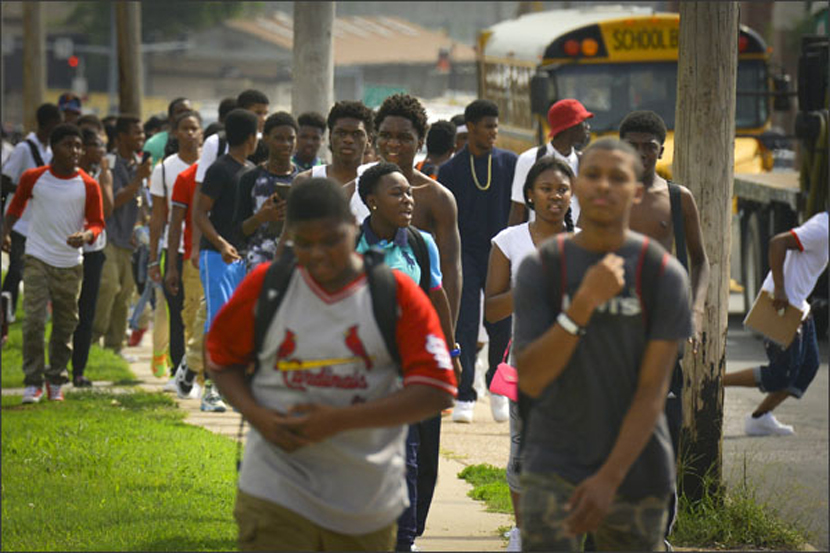
Out of Missouri’s 520 school systems, Normandy is one of just two that are unaccredited. (Photographic Credit; EdWeek)
For Nedra Martin, whose honors student daughter, Mah’Ria, was stuck in Normandy’s failing schools, the development was the miracle she had prayed for. Martin could not afford private schools, and her attempts to enroll her daughter in neighboring white districts had been rebuffed.
Just like that, the court’s decision erased the invisible, impenetrable lines of segregation that had trapped her child.
“I was elated,” Martin said. “Just elated.”
Parents in the school districts that would have to take Normandy’s students were not. Normandy had chosen to provide transportation for its transfers to attend Francis Howell, which was 85 percent white at the time and some 26 miles away.
When Francis Howell officials held a public forum to address community concerns, more than 2,500 parents packed into the high school gymnasium.
Would the district install metal detectors? What about the violence their children would be subjected to, an elementary school parent asked. Wouldn’t test scores plummet? The issue wasn’t about race, one parent said, “but trash.”
Mah’Ria Martin was sitting in the audience that night with her mother. One of the few brown faces in the audience, the rising 8th grader said she wiped away tears.
“It made me heartbroken because they were putting us in a box,” said Mah’Ria, soft spoken but firm, in recalling the episode. “I was sitting there thinking, ‘Would you want some other parents talking about your kid that way?’”
In the fall of 2013, nearly 1,000 Normandy students — about a quarter of the district’s enrollment — fled to schools in accredited districts. More than 400, including Mah’Ria, headed to Francis Howell.
Mah’Ria said that she was, in fact, welcomed by students and teachers at her new middle school. It was the first time in her life that she’d attended a district that had the full approval of the state.
She thrived. And she was not alone.
Despite the fears, recently released state data shows that, with the exception of one district, test scores in the transfer schools did not drop.
But the success came with a perverse twist. The state required failing districts whose students were allowed to transfer to pay the costs of the children’s education in the adjoining districts. For the whiter, more affluent districts, it was a replay of what had happened during the court-ordered desegration plan, when transfer students were referred to as “black gold”: students the districts had to educate but who cost them nothing.
The millions of dollars in payments to other districts drained Normandy’s finances. Within months, the district shuttered an elementary school and laid off 40 percent of its staff. Already deeply troubled, the Normandy schools were headed to insolvency.
“In order to save the district, they killed the district,” said John Wright, a longtime St. Louis educator who spent stints as superintendent in both St. Louis and Normandy.
Recognizing the problem of student transfers, the state engineered their end.
This June, when students were on summer break, the state announced that it was taking over the Normandy Public Schools district and reconstituting it as the Normandy Schools Collaborative. As a new educational entity, state officials said, the district got a clean slate. It no longer was unaccredited but operated under a newly created status as a “state oversight district.”
The transfer program, the state claimed, no longer applied. One by one, transfer districts announced that Normandy children were no longer welcome.

Mah’Ria Pruitt-Martin, center, an honors student, transferred out of Normandy last year but returned after the state tried to end student transfers to high-performing districts. In November, her mother pulled Mah’Ria out of the Normandy schools again because she said she saw little improvement. (Whitney Curtis for ProPublica)
Martin and her daughter were devastated. “I honestly felt they were blacklisting our children,” Martin said.
Martin and other parents sued, asserting the state had no legal authority to act as it had. St. Louis lawyer Josh Schindler represented the parents.
“These are just families who want their kids to have a good education. Decent, hard-working people who want their kids to have a chance,” he said in an interview. “This has been a decades-long battle. How are we going to remedy the situation?”
On August 15, after the new school year had begun in some districts, a state judge granted a temporary injunction that allowed the plaintiffs to enroll their children in the transfer districts.
“Every day a student attends an unaccredited school,” the judge wrote, the child “could suffer harm that cannot be repaired.”
The ruling brought a rush of relief to many parents.
“I cried and just held onto my kid,” said Janine Crawford, whose son was able return to the Pattonville School District. “It meant that he was going to get a decent education. And it meant that I could take a deep breath.”
The state is still fighting the ruling, and Francis Howell required all transfer students to obtain court orders to return.
Martin briefly returned Mah’Ria to the Normandy schools after they came under state oversight but found them little improved and has since sent her back to Frances Howell. The entire situation has only reinforced her cynicism and despair, she said.
“What about your neighbor? Is it so hard to embrace the children who clearly need your help right now?” she asked. “The whole way this was handled by the state on down was sheisty and underhanded. They were not thinking about the children.”
The state’s top education officials admit that the way they’ve dealt with Normandy has laid bare racial divisions in St. Louis County and beyond. In an interview, Nicastro, the state superintendent, called it a “low point” in her career, a “blight and commentary about Missouri.”
When asked whether black children in Missouri were receiving an equal education, she paused, then inhaled deeply. “Do I think black children in Missouri are getting in all cases the same education as their white counterparts?” Nicastro said. “I’d have to say no.”
Little Hope and a Telling Burial
On a cold, clear morning in November, with the grand jury still assessing the killing of Michael Brown, a group of black leaders and concerned citizens gathered in a classroom at Harris-Stowe State University in downtown St. Louis. The school was founded in 1829 to train black teachers.
The gathering produced a recommitment to the solution to segregation floated 30 years before: A single, unified school district for St. Louis and its suburbs.
But there was recognition that the answer would require a long and uphill fight.
“We know what would have been best educationally for these kids — we always know what the best thing to do is. What we lack is the moral courage and political will to do it,” said Jones, of the state Board of Education. “If we had treated the civil rights movement the way we’ve treated the education of black children, we’d still be drinking out of colored drinking fountains.”
Separate but equal has not worked, Jones said. Not in St. Louis. Not anywhere else. The school lines that advantage some and deprive others, he said, must be toppled.
Students who spend their careers in segregated schools can look forward to a life on the margins, according to a 2014 study on the long-term impacts of school desegregation by University of California, Berkeley economist Rucker Johnson. They are more likely to be poor. They are more likely to go to jail. They are less likely to graduate from high school, to go to college, and to finish if they go. They are more likely to live in segregated neighborhoods as adults.

Michael Brown is buried in the cemetery a few yards from his former High School. (CNN News)
Their children are more likely to also attend segregated schools, repeating the cycle.
Even in the fog of her grief, Michael Brown’s mother spoke to this struggle. With her son’s body laying on the concrete behind police tape, Lesley McSpadden cried, “Do you know how hard it was for me to get him to stay in school and graduate?
“You know how many black men graduate?” she implored. “Not many.”
With a diploma from a district that one report called “catastrophically underperforming,” her oldest son had been headed to nearby Vatterott College.
Schools like Vatterott enroll a disproportionate percentage of black students. Those who attend are often saddled with debt they cannot pay back. In 2013, a jury awarded more than $13 million to a single mother who sued Vatterott for misleading enrollment practices.
An executive with Vatterott Educational Centers, Inc. said the company’s problems were in the past, and that it had reformed its admissions practices.
Brown never made it to Vatterott. Maybe he would have bucked the odds and found a way to master a trade and make a career.
Today, Brown is buried in the old St. Peter’s Cemetery. Right next to Normandy High School.
This story was co-published with the New York Times. We’re working with The Times to expose the injustice of segregation and explore what segregation looks and feels like in America today. Tell us about your everyday experiences with segregation by tweeting your stories and photos with #SegregationIs and adding your comments below.
ProPublica’s Nikole Hannah-Jones has spent the last two years exploring race in America. Read her investigation on the resegregation of schools or join her on Facebook for an ongoing conversation on race and civil rights.
Some of the images, along with the stellar information, was reprinted by EmpathyEducates with the kind permission of ProPublica. We are grateful for the research, investigation, reporting and visual expressions.
